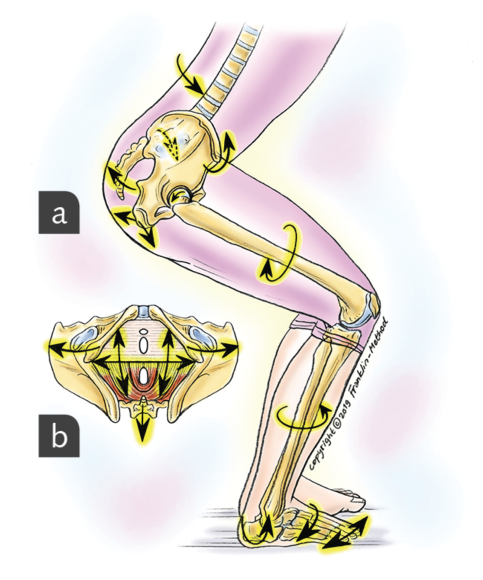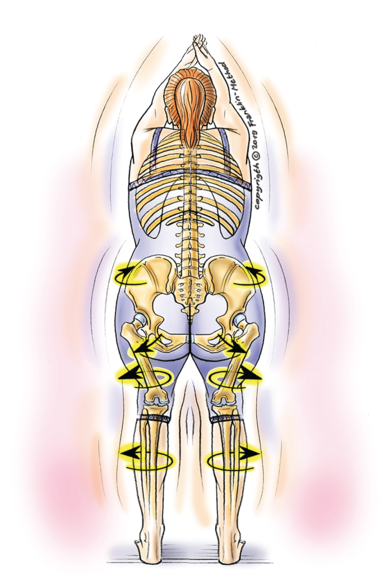Pelvic Anatomy and Function - Bone Rhythms
This is an excerpt from Understanding the Pelvis by Eric Franklin,Alison Wesley.
Bone Rhythms
The counterrotation of the bones continues all down the leg and through the foot. In the Franklin Method we call the natural and safe way bones move the bone rhythms (figure 23).

What's the purpose of this movement, and why is this purpose not readily apparent? When you bend and stretch your legs, you may tend to see that your knees move forward and your pelvis moves down; you might miss the counterrotations that are happening at the same time.
There are two fundamental reasons why the bone rhythms are important. Compared to quadrupeds who move around with their knees flexed, humans walk with fairly straight knees. In humans, the pelvis coasts over the stance leg as if it were a beam. This reaction in the pelvis is reminiscent of pole vaulting, or of a gondola in Venice being propelled by a long oar. Bone rhythms allow the leg to switch back and forth efficiently from being a rigid strut to a more flexible absorptive configuration. This saves a lot of energy.
If your knees were bent and the heels lifted, as in a dog, you would need to engage your quadriceps and hamstrings a lot more than you do. The advantage of being a quadruped is that it has four cylinders (legs) to power its movement. On the other hand, humans have much more endurance, which has great evolutionary advantages. Animals do not run marathons.
Another advantage of counterrotation is force absorption and force generation. Efficient movement means a high energy-to-output ratio. The human musculoskeletal system engages all three dimensions to improve efficiency. When you bend your knees as you land from a jump, your leg bones aren't just moving forward; they're also counterrotating to improve force absorption in all dimensions (figure 24). Imagine yourself on skis speeding down a slope; if you suddenly needed to stop, you would improve force absorption by swinging your skis into a curve. Nevertheless your knees would appear to stay aligned over the second toe because the tibial plateau is moving in exact opposition to the femur condyles.

The traditional approach to teaching alignment is to focus on bony landmarks and their relationship to each other. Once the landmarks, such as the knees, are in the right position, over the second toe, we are aligned. While this idea is helpful, it does not reflect the nature of human movement, because these landmarks move relative to each other as you bend and stretch your legs. The knee oscillates over the second toe. The more you bend your knee, the farther the knee is aligned medially to the second toe; when you stretch your knee, the alignment moves more laterally.
Alignment and force absorption are compatible, as long as you're practicing the concept of moving stability. The line of gravity through the leg remains stable even as bony landmarks are shifting. Trying to maintain the configuration of bony points in a fixed position can actually block movement rather than enhance it.
The challenge of moving toward dynamic alignment is often psychological. If you've been taught the static, positional model of alignment, it might be challenging at first to grasp the concept of moving stability.
But it can't be denied that the use of three-dimensional force absorption and production best supports the dynamic nature of human alignment, creating optimal efficiency in movement. Once you embody this theory, you will observe rapid progress in your yoga practice.
In fine-tuned motor control, sacral nutation and pelvic movement initiate simultaneously, while the innominate bone moves relatively in opposition to both these bones. This is the key to a free hip joint and dynamic pelvic movement.
In hip extension the opposite motions take place: the sacrum counternutates, the femurs rotate internally, and the innominate bone nutates relative to the sacrum.
More Excerpts From Understanding the PelvisSHOP

Get the latest insights with regular newsletters, plus periodic product information and special insider offers.
JOIN NOW


